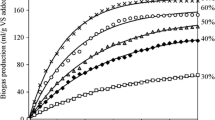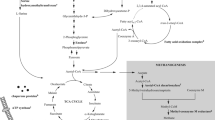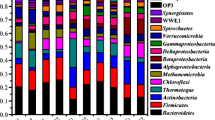Abstract
Anaerobic digestion of wastewater sludge (WS) has received limited attention worldwide in many wastewater treatment plants (WWTPs). This study investigated the potential of valorizing WS generated from a WWTP in Lebanon for enhanced methane production and digestate recovery. Batch experiments were conducted, and the results showed cumulative methane yields of 0.3403, 0.4179, and 0.4643 Nm3CH4 kgVS−1 for untreated WS, WS + 6% NaOH, and WS + 10% NaOH, respectively. Biochemical characterization of the sludge revealed that the alkaline pretreatment increased methane production volume and kinetics by solubilizing hemicellulose, cellulose, and lignin. The process was scaled up using continuous digesters with an HRT of 30 days and an OLR of 3.56 KgVS m−3 d−1, and it was found that alkaline treatment enhanced WS methane production by about 37% compared to the control. Moreover, the digestate was examined for its quality, and the results showed that the Germination Index (> 60%) and Escherichia coli concentration (3 CFU g−1) were within the appropriate values of international legislation on compost quality, indicating its potential for use in agriculture. Finally, a large-scale digester was designed based on a case study, and calculations showed that it could recover up to 18% of the WWTP’s annual electrical consumption. The study’s outcomes suggest that the anaerobic digestion of WS can be an effective strategy for bioenergy and nutrient recovery in WWTPs and could have broader applications in other countries facing similar challenges.






Similar content being viewed by others
References
Sharma, M., et al.: Wastewater treatment and sludge management strategies for environmental sustainability. In: Stefanakis, A.; Nikolaou, I. (Eds.) Circular Economy and Sustainability, pp. 97–112. Elsevier (2022). https://doi.org/10.1016/B978-0-12-821664-4.00027-3
Topal, M.; Arslan Topal, E.I.: Investigation of critical raw materials in sludge of municipal wastewater treatment plant. Arab. J. Sci. Eng. 48(1), 107–115 (2023). https://doi.org/10.1007/s13369-022-07238-x
Agoro, M.A.; Adeniji, A.O.; Adefisoye, M.A.; Okoh, O.O.: Heavy metals in wastewater and sewage sludge from selected municipal treatment plants in Eastern Cape Province, South Africa. Water 12(10), 10 (2020). https://doi.org/10.3390/w12102746
Baby, M.G.; Ahammed, M.M.: Nutrient removal and recovery from wastewater by microbial fuel cell-based systems: a review. Water Sci. Technol. 86(1), 29–55 (2022). https://doi.org/10.2166/wst.2022.196
Al-Gheethi, A.A.; Efaq, A.N.; Bala, J.D.; Norli, I.; Abdel-Monem, M.O.; Ab, M.O.: Removal of pathogenic bacteria from sewage-treated effluent and biosolids for agricultural purposes. Appl. Water Sci. 8(2), 74 (2018). https://doi.org/10.1007/s13201-018-0698-6
Khawer, M.U.B., et al.: Anaerobic digestion of sewage sludge for biogas & biohydrogen production: State-of-the-art trends and prospects. Fuel 329, 125416 (2022). https://doi.org/10.1016/j.fuel.2022.125416
El Achkar, J.; Rohayem, C.; Salameh, D.; Louka, N.; Maroun, R.; Hobaika, Z.: Olive pomace, a source of green energy using anaerobic digestion. 2018, p. 6. https://doi.org/10.1109/REDEC.2018.8598079
El Achkar, J.; Baydoun, A.; Salameh, D.; Louka, N.; Hobaika, Z.; Maroun, R.: Can coffee grounds be considered as a potential for green energy production? 2018, p. 6. https://doi.org/10.1109/REDEC.2018.8598105
El Achkar, J.H., et al.: Could petroleum sludge be used to produce biomethane as a renewable energy source? Presented at the ADIPEC. OnePetro (2022). https://doi.org/10.2118/210953-MS
El Achkar, J.H.; Ziade, R.; Louka, N.; Maroun, R.G.; Hobaika, Z.: Treatment of dairy waste by anaerobic digestion to produce methane as green energy. In: 2020 5th International Conference on Renewable Energies for Developing Countries (REDEC), Jun. 2020, pp. 1–6. https://doi.org/10.1109/REDEC49234.2020.9163848
El Achkar, J.H., et al.: Anaerobic digestion of nine varieties of grape pomace: correlation between biochemical composition and methane production. Biomass Bioenergy 107, 335–344 (2017). https://doi.org/10.1016/j.biombioe.2017.10.030
El Achkar, J.H., et al.: Anaerobic digestion of grape pomace: Biochemical characterization of the fractions and methane production in batch and continuous digesters. Waste Manag. 50, 275–282 (2016). https://doi.org/10.1016/j.wasman.2016.02.028
El Achkar, J.H., et al.: Influence of pretreatment conditions on lignocellulosic fractions and methane production from grape pomace. Bioresour. Technol. 247, 881–889 (2018). https://doi.org/10.1016/j.biortech.2017.09.182
El Achkar, J.H., et al.: Anaerobic digestion of grape pomace: Effect of the hydraulic retention time on process performance and fibers degradability. Waste Manag. 71, 137–146 (2018). https://doi.org/10.1016/j.wasman.2017.11.005
Sukkar, K.A.; Al-Zuhairi, F.K.; Dawood, E.A.: Evaluating the influence of temperature and flow rate on biogas production from wood waste via a packed-bed bioreactor. Arab. J. Sci. Eng. 46(7), 6167–6175 (2021). https://doi.org/10.1007/s13369-020-04900-0
Atelge, M.R., et al.: A critical review of pretreatment technologies to enhance anaerobic digestion and energy recovery. Fuel 270, 117494 (2020). https://doi.org/10.1016/j.fuel.2020.117494
Khanh Nguyen, V., et al.: Review on pretreatment techniques to improve anaerobic digestion of sewage sludge. Fuel 285, 119105 (2021). https://doi.org/10.1016/j.fuel.2020.119105
Neumann, P.; Pesante, S.; Venegas, M.; Vidal, G.: Developments in pre-treatment methods to improve anaerobic digestion of sewage sludge. Rev. Environ. Sci. Biotechnol. 15(2), 173–211 (2016). https://doi.org/10.1007/s11157-016-9396-8
Yang, G.; Wang, J.: Enhancing biohydrogen production from waste activated sludge disintegrated by sodium citrate. Fuel 258, 116177 (2019). https://doi.org/10.1016/j.fuel.2019.116177
Hameed, S.A., et al.: Microbial population dynamics in temperature-phased anaerobic digestion of municipal wastewater sludge. J. Chem. Technol. Biotechnol. 94(6), 1816–1831 (2019). https://doi.org/10.1002/jctb.5955
Wang, S., et al.: Development of an alkaline/acid pre-treatment and anaerobic digestion (APAD) process for methane generation from waste activated sludge. Sci. Total Environ. 708, 134564 (2020). https://doi.org/10.1016/j.scitotenv.2019.134564
Behera, S.; Arora, R.; Nandhagopal, N.; Kumar, S.: Importance of chemical pretreatment for bioconversion of lignocellulosic biomass. Renew. Sustain. Energy Rev. 36, 91–106 (2014). https://doi.org/10.1016/j.rser.2014.04.047
American Public Health Association, A. D. Eaton, American Water Works Association, and Water Environment Federation, Standard methods for the examination of water and wastewater. Washington, D.C.: APHA-AWWA-WEF, (2005)
Lawlor, K., et al.: Comparison of methods to investigate microbial populations in soils under different agricultural management. FEMS Microbiol. Ecol. 33(2), 129–137 (2000). https://doi.org/10.1111/j.1574-6941.2000.tb00735.x
editors E. W. R. B. B. D. E. S. Clesceri, Standard Methods for the Examination of Water and Wastewater, 22nd Edition, 22nd edition. Washington (D.C.): American Water Works Association, 2012.
Hoekstra, N.J.; Bosker, T.; Lantinga, E.A.: Effects of cattle dung from farms with different feeding strategies on germination and initial root growth of cress (Lepidium sativum L.). Agric. Ecosyst. Environ. 93(1), 189–196 (2002). https://doi.org/10.1016/S0167-8809(01)00348-6
Angelidaki, I., et al.: Defining the biomethane potential (BMP) of solid organic wastes and energy crops: a proposed protocol for batch assays. Water Sci. Technol. 59(5), 927–934 (2009). https://doi.org/10.2166/wst.2009.040
Ghaleb, A.A.S., et al.: Response surface methodology to optimize methane production from mesophilic anaerobic co-digestion of oily-biological sludge and sugarcane bagasse. Sustainability 12(5), 5 (2020). https://doi.org/10.3390/su12052116
Rabii, A.; Aldin, S.; Dahman, Y.; Elbeshbishy, E.: A review on anaerobic co-digestion with a focus on the microbial populations and the effect of multi-stage digester configuration. Energies 12(6), 6 (2019). https://doi.org/10.3390/en12061106
Sills, D.L.; Gossett, J.M.: Assessment of commercial hemicellulases for saccharification of alkaline pretreated perennial biomass. Bioresour. Technol. 102(2), 1389–1398 (2011). https://doi.org/10.1016/j.biortech.2010.09.035
Hendriks, A.T.W.M.; Zeeman, G.: Pretreatments to enhance the digestibility of lignocellulosic biomass. Bioresour. Technol. 100(1), 10–18 (2009). https://doi.org/10.1016/j.biortech.2008.05.027
Chen, X.; Gu, Y.; Zhou, X.; Zhang, Y.: Asparagus stem as a new lignocellulosic biomass feedstock for anaerobic digestion: increasing hydrolysis rate, methane production and biodegradability by alkaline pretreatment. Bioresour. Technol. 164, 78–85 (2014). https://doi.org/10.1016/j.biortech.2014.04.070
Xie, S.; Frost, J.P.; Lawlor, P.G.; Wu, G.; Zhan, X.: Effects of thermo-chemical pre-treatment of grass silage on methane production by anaerobic digestion. Bioresour. Technol. 102(19), 8748–8755 (2011). https://doi.org/10.1016/j.biortech.2011.07.078
Monlau, F.; Barakat, A.; Steyer, J.P.; Carrere, H.: Comparison of seven types of thermo-chemical pretreatments on the structural features and anaerobic digestion of sunflower stalks. Bioresour. Technol. 120, 241–247 (2012). https://doi.org/10.1016/j.biortech.2012.06.040
Peyrelasse, C.; Barakat, A.; Lagnet, C.; Kaparaju, P.; Monlau, F.: Anaerobic digestion of wastewater sludge and alkaline-pretreated wheat straw at semi-continuous pilot scale: performances and energy assessment. Energies 14(17), 17 (2021). https://doi.org/10.3390/en14175391
Peyrelasse, C.; Kaparaju, P.; Lallement, A.; Marques, M.; Monlau, F.: Reduction of the environmental footprint of thermo-alkali pretreatment by reusing black liquor during anaerobic digestion of lignocellulosic biomasses. Biofuels Bioprod. Biorefining 15(3), 657–670 (2021). https://doi.org/10.1002/bbb.2208
Yadvika, S.; Sreekrishnan, T.R.; Kohli, S.; Rana, V.: Enhancement of biogas production from solid substrates using different techniques––a review. Bioresour. Technol. 95(1), 1–10 (2004). https://doi.org/10.1016/j.biortech.2004.02.010
Callaghan, F.J.; Wase, D.A.J.; Thayanithy, K.; Forster, C.F.: Continuous co-digestion of cattle slurry with fruit and vegetable wastes and chicken manure. Biomass Bioenergy 22(1), 71–77 (2002). https://doi.org/10.1016/S0961-9534(01)00057-5
Ahring, B.K.; Sandberg, M.; Angelidaki, I.: Volatile fatty acids as indicators of process imbalance in anaerobic digestors. Appl. Microbiol. Biotechnol. 43(3), 559–565 (1995). https://doi.org/10.1007/BF00218466
Vavilin, V.A.; Rytov, S.V.; Lokshina, L.Y.: A balance between hydrolysis and methanogenesis during the anaerobic digestion of organic matter. Microbiology 66(6), 712–717 (1997)
Di Girolamo, G.; Bertin, L.; Capecchi, L.; Ciavatta, C.; Barbanti, L.: Mild alkaline pre-treatments loosen fibre structure enhancing methane production from biomass crops and residues. Biomass Bioenergy 71, 318–329 (2014). https://doi.org/10.1016/j.biombioe.2014.09.025
Kafle, G.K.; Kim, S.H.: Anaerobic treatment of apple waste with swine manure for biogas production: Batch and continuous operation. Appl. Energy 103, 61–72 (2013). https://doi.org/10.1016/j.apenergy.2012.10.018
Sambusiti, C.; Ficara, E.; Malpei, F.; Steyer, J.P.; Carrère, H.: Benefit of sodium hydroxide pretreatment of ensiled sorghum forage on the anaerobic reactor stability and methane production. Bioresour. Technol. 144, 149–155 (2013). https://doi.org/10.1016/j.biortech.2013.06.095
Cieślik, B.M.; Namieśnik, J.; Konieczka, P.: Review of sewage sludge management: standards, regulations and analytical methods. J. Clean. Prod. 90, 1–15 (2015). https://doi.org/10.1016/j.jclepro.2014.11.031
Wainaina, S., et al.: Resource recovery and circular economy from organic solid waste using aerobic and anaerobic digestion technologies. Bioresour. Technol. 301, 122778 (2020). https://doi.org/10.1016/j.biortech.2020.122778
Elalami, D.; Carrere, H.; Monlau, F.; Abdelouahdi, K.; Oukarroum, A.; Barakat, A.: Pretreatment and co-digestion of wastewater sludge for biogas production: recent research advances and trends. Renew. Sustain. Energy Rev. 114, 109287 (2019). https://doi.org/10.1016/j.rser.2019.109287
Misson, G.; Mainardis, M.; Incerti, G.; Goi, D.; Peressotti, A.: Preliminary evaluation of potential methane production from anaerobic digestion of beach-cast seagrass wrack: the case study of high-adriatic coast. J. Clean. Prod. 254, 120131 (2020). https://doi.org/10.1016/j.jclepro.2020.120131
Fytili, D.; Zabaniotou, A.: Utilization of sewage sludge in EU application of old and new methods—a review. Renew. Sustain. Energy Rev. 12(1), 116–140 (2008). https://doi.org/10.1016/j.rser.2006.05.014
Nafez, A.H.; Nikaeen, M.; Kadkhodaie, S.; Hatamzadeh, M.; Moghim, S.: Sewage sludge composting: quality assessment for agricultural application. Environ. Monit. Assess. 187(11), 709 (2015). https://doi.org/10.1007/s10661-015-4940-5
Wang, P.; Changa, C.M.; Watson, M.E.; Dick, W.A.; Chen, Y.; Hoitink, H.A.J.: Maturity indices for composted dairy and pig manures. Soil Biol. Biochem. 36(5), 767–776 (2004). https://doi.org/10.1016/j.soilbio.2003.12.012
Saveyn, H.; Eder, P.: End-of-waste criteria for biodegradable waste subjected to biological treatment (compost & digestate): Technical proposals. JRC Publications Repository, Jan. 14, 2014. https://publicationstest.jrc.cec.eu.int/repository/handle/JRC87124. Accessed 01 Mar 2023
Regulation (EU) 2019/1009 of the European Parliament and of the Council of 5 June 2019 laying down rules on the making available on the market of EU fertilising products and amending Regulations (EC) No 1069/2009 and (EC) No 1107/2009 and repealing Regulation (EC) No 2003/2003 (Text with EEA relevance)Text with EEA relevance. 2022. Accessed: Mar. 01, 2023. [Online]. Available: http://data.europa.eu/eli/reg/2019/1009/2022-10-03/eng
Andreoli, C.V.; von Sperling, M.; Fernandes, F.: Sludge Treatment and Disposal. IWA Publishing (2007) https://doi.org/10.2166/9781780402130
Turovskiy, I.S.; Mathai, P.K.: Wastewater Sludge Processing. Wiley, Berlin (2006)
Li, H.; Jin, C.; Zhang, Z.; O’Hara, I.; Mundree, S.: Environmental and economic life cycle assessment of energy recovery from sewage sludge through different anaerobic digestion pathways. Energy 126, 649–657 (2017). https://doi.org/10.1016/j.energy.2017.03.068
"Progressive Cavity Pumps: Slurry, Paste Pumping," Flowrox, 2020. https://flowrox.com/product/progressive-cavity-pumps/. Accessed 08 Dec 2021
Singh, B.; Szamosi, Z.; Siménfalvi, Z.: Impact of mixing intensity and duration on biogas production in an anaerobic digester: a review. Crit. Rev. Biotechnol. 40(4), 508–521 (2020). https://doi.org/10.1080/07388551.2020.1731413
"Fuel Gases - Heating Values," 2005. https://www.engineeringtoolbox.com/heating-values-fuel-gases-d_823.html. Accessed 09 Dec 2021
Zallaya, S.; El Achkar, J.H.; Chacra, A.A.; Shatila, S.; El Akhdar, J.; Daher, Y.: Steam gasification modeling of polyethylene (PE) and polyethylene terephthalate (PET) wastes: a case study. Chem. Eng. Sci. 267, 118340 (2023). https://doi.org/10.1016/j.ces.2022.118340
Author information
Authors and Affiliations
Corresponding author
Rights and permissions
Springer Nature or its licensor (e.g. a society or other partner) holds exclusive rights to this article under a publishing agreement with the author(s) or other rightsholder(s); author self-archiving of the accepted manuscript version of this article is solely governed by the terms of such publishing agreement and applicable law.
About this article
Cite this article
El Achkar, J.H., El Joauhari, A., Nassreddine, C. et al. Anaerobic Digestion of Wastewater Sludge for Improved Energy Recovery: Alkaline Pretreatment Impact, Digestate Quality Assessment, and Reactor Design. Arab J Sci Eng 48, 16109–16121 (2023). https://doi.org/10.1007/s13369-023-08068-1
Received:
Accepted:
Published:
Issue Date:
DOI: https://doi.org/10.1007/s13369-023-08068-1




